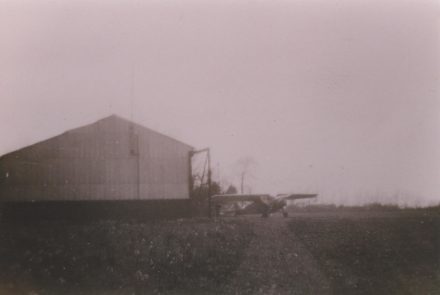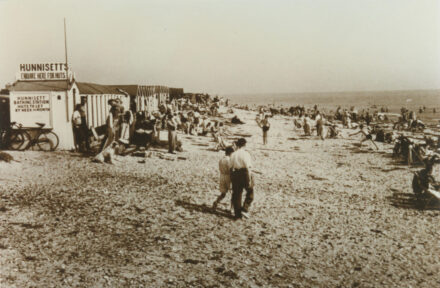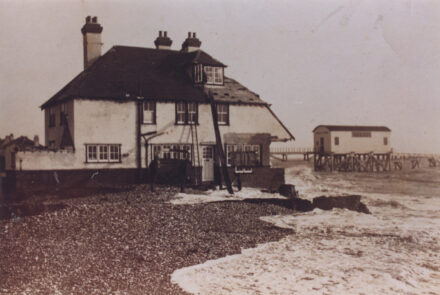Back in 2000 Cliff Fidler wrote an article in Selsey Life entitled ‘The House in Fish Lane where Miss Melsom lived until 1953’. In fact, this article focussed on coastal erosion and described which houses had been lost to the sea at the end of Fish Lane, which we know as Albion Road.
By now, you would have expected me to give you a synopsis of Miss Melsome’s life but beyond her birth date (14 March 1885)taken from the 1939 Register, and her death date(29 January 1959) taken from the National Probate Calendar on Ancestry there is little else to find. Several young ladies share the name and were born in Wales, Ryde on the IOW and Wiltshire. Some of them can be discounted by their date of birth. Others just don’t ‘feel’ right – one young lady is 25 in the 1901 census and 30 in the 1911 census. To make matters worse she appears in the records as Edith May or even Alice along with Melsom, Nelson and Melson. So we have to stick with what we do know about the lady – and that is the house in which she lived.
Miss Melsome, allegedly, moved into the house just after WW1 but the earliest record I can find is Kelly’s Directory of 1924 when, indeed, she is here and living at Gorse Bush, Albion Road. There is no entry for 1930 but, in 1933 a Miss Powell lived at Gorse Bush, aka Gorse Bush Cottage. Apart from another entry for 1954 the trail goes cold so we are left with newspaper articles to fill in the gaps.

The Hampshire Telegraph of 20 January 1933 reported a court case involving Miss Melsom of Albert Road, Selsey (aka Miss Melsome of Albion Road!) who was disputing a letting. Miss Melsom claimed £10 guineas (£10.10 shillings or £10.50 pence depending on your age!) from a London lady who was a manufacturer of ladies’ and children’s wear. She ‘took rooms’ from August 17 to August 31 at 5 guineas a week but left at the end of one week as she was ‘not made comfortable’.
The London lady had shot herself in the foot as she had written a letter to Miss Melsome saying she wanted the rooms for an indefinite period and the letter was produced as evidence. Miss Melsome felt she was owed the 5 guineas and was awarded them plus costs.
Later in the year we find Miss Melsome serving on the Committee of the Missionary Association and in 1934 she was winning numerous prizes at the Selsey Flower Show alongside such luminaries as Mrs. Barford, Mrs S Woodland and Mr Godel. She came 3rd in the ‘best vase of roses’ category, 2nd with her peas and 1st with cabbages, gooseberries and blackcurrants. One of the judges commented that there appeared to be only 10 gardeners in Selsey as the same names kept appearing in all classes!
In June 1935 there was a Sale of Work in the garden of Rectory House in aid of ‘foreign missions’ at which £50 was realised despite the very wet afternoon. Miss Melsome was on the book stall with Miss Escombe and Miss Morris. Miss Melsome won prizes for her blackcurrants, redcurrants and six kinds of vegetables and attended the AGM of the Missionary Society at the Church Hall at which she was voted in to continue her work on the Committee.
There was more of the same during 1936 and, presumably 1937. In 1938 we find our heroine serving on the General Committee of the Women’s Branch of the Conservative Association. We then jump to 1944 when Messrs. Wyatt & Son were instructed to sell ‘the freehold detached residence known as Beacon Villa, Albion Road also the adjoining freehold detached residence known as Gorse Bush, Albion Road.’ Auction notices are always useful sources of information. Beacon Villa had ‘3 reception rooms, 7 bedrooms, bathroom, kitchen, scullery etc. having gas and main water laid on, cesspool drainage and large garden.’ Gorse Bush had ‘similar accommodation and conveniences’ and was ‘let on a quarterly tenancy producing £42 per annum (tenant paying the rates).’ From this it leads us to believe that although Miss Melsome lived in Gorse Bush she didn’t own it and supplemented her income by letting rooms to holidaymakers.
The Bognor Regis Observer of 10 January 1948 trumpeted ‘POULTRY RUSTLER IMPRISONED. Christmas Eve Chicken Theft.’ A man was accused of stealing four chickens, valued at £5. Miss Edith Nelson (sic) kept a number of chickens in the backyard but their wooden shed was broken into and she discovered the loss on Christmas Morning. One chicken was recovered but the remaining three had been sold.
In 1952 Miss Melsome’s peaceful and useful life was turned upside down. The Portsmouth Evening News of 2 January 1952 carried the headline ‘SELSEY WANTS R.E’s HELP’.
‘After a period of comparative calm, an anxious watch was kept again last night on the vulnerable area lying to the east of Selsey Bill. Whisked up by a south-westerly gale, heavy seas flooded Albion Road as far as St. Ursula’s School, and part of the roadway itself – some 5ft. wide – was washed away. Shingle was flung up between the houses. The remaining piece of cliff separating the steps leading to the lifeboat house from the sea was also washed away, leaving only a narrow 3ft. margin. Seas flooded through No. 2, South-East Villas, once more, bursting open the boarded up doors and windows, while further eastwards the low lying area in the Forties, opposite the breach in the shingle bank, was again badly flooded.’
At other places the Royal Engineers had been called in but ‘nothing had been done at Selsey to put matters right before the storms caused fresh destruction.’

Left- Residents seen salvaging furniture from houses at Selsey when the tide had receded and the house was no longer being lashed by the seas. The waves swept over the shingle bank at Selsey into the low-lying land behind. Many acres were inundated and families in threatened bungalows near the shore were helped by police and fishermen to a temporary shelter for the night. The Sphere, 5 January 1952.
We can see just how close these houses were to the Lifeboat gantry.
One tragic occurrence was reported in the Daily Herald of 8 January 1952 ‘when householders went to a meeting in the village hall to demand improved sea-defence measures. Among them was Mr. Cecil Freeman, 78-year-old optician. He asked why concrete anti-invasion blocks had been dumped into gravel pits after the war instead of being used for protection against the sea. He did not hear the answer. For Mr Freeman collapsed and died.’
More livestock was the subject of another case at Chichester County Court in July, 1952 when two ducks were stolen from Miss Edith May Melson (sic) and she was awarded £2 and costs. Two men had walked off with the ducks which then appeared in the neighbour’s garden. As the neighbour was unable to provide evidence that they were her property she had to pay for them. The judge commented it was ‘a very unsatisfactory case’.
Newspaper coverage continued nationwide and Selsey appeared again in The Sphere of 25 October 1952.
This image shows ‘a repair gang at work on the beach fortifications at the Sussex seaside town. Just in front of the men the sea is seen crashing over one of the former barricades.’

The second picture, below, ‘shows a section of the eroded coastline at Selsey, showing the groynes and seawalls which have been erected in an attempt to hold back the sea.’

As we have seen from the first picture in the article, Miss Melsome’s house did survive but not for very long. By 6 February 1954 newspapers all over the country were reporting on Miss Melsome’s house being wrecked. There are reports from the Belfast Telegraph, Yorkshire Evening Post, Evening News, Northern Daily Mail (West Hartlepool).
The most dramatic one is, perhaps, the one from the Evening News:
‘WOMAN STAYS IN DOOMED SELSEY HOME’.
‘Another section of her sea-front home collapsed yesterday afternoon, but Miss E M Melsome, a 70-year-0ld recluse still refuses to leave her ten-roomed house at Albion Road, Selsey. By yesterday morning most of the seaward-side walls had collapsed over frothing waves, which undermined the foundations. A downstairs room was also washed away. In the afternoon, part of the overhanging top floor suddenly crashed down. ‘it was like a gun going off’ said a neighbour.’
Neighbours, welfare officers, parish councillors and police had spent two years trying to persuade her to leave but her response was always ‘Why should I leave? Everything I have is here’. Instead she spent her nights at a neighbour’s cottage but returned to her own home to feed the chickens, ducks and five pet cats.
I rather enjoyed the headline from the Northern Daily Mail though: ‘OLD LADY – AND CATS – DEFY THE SEA’

Yet again, people rescued her furniture and, yet again, we have a conundrum. The implication of the Auction Sale in 1944 is that Gorse Bush was occupied by a tenant but The Bognor Regis Observer of 12 February 1954 reported that ‘she had bought Gorse Bush with the intention of living there until she died…’
By 11 February Miss Melsome had no electricity, gas or water but still she stayed in her house all day. The last straw was when a giant wave swept away the dining-room and the room above and flooded all the ground floor.
By the 12th, the roof had collapsed, the staircase became impassable and Miss Melsome moved to a two bedroom shack farther along the beach.
Neighbours helped her by providing hot meals and another offered her a wooden bungalow in East Road which the owner was willing to lend to her. The destruction was complete.

The West Sussex Gazette of 2 December 1954 reported that ‘Miss E M Melsome…was again forced to abandon her home. Police found that the sea had badly damaged the front of the shack further inland to which she had moved. Barricades were up, but they broke in and found Miss Melsome sitting on a chair with water covering the floor. Despite her protests, they carried her to a safer place. Less than half an hour later the building was submerged.’
On 16 December, the same newspaper carried a report of a meeting of Chichester RDC and it mentions that Miss Melsome could be given accommodation at ‘a hutted camp in Donnington.’ This appears not to have happened because on 29 January 1959 Miss Melsome died and her address at that time was 40 North Road.
I am grateful to Jack Tupper for telling me that ‘the roof timbers were all swept to the West and ended up on the West Beach in the region of West Sands Caravan Park. On occasions like this, a considerable number of people, including my Father and myself would go down to the area with trailers and pick up the timber, particularly as it was difficult to come by bearing in mind that there had been Building Licences after the War.’
And if the current inhabitants of 18 Woodland Road have an elderly shed in their garden then it is constructed of wood from Miss Melsome’s house.
Jack also remembers that Miss Melsome possessed a bicycle but he never saw her actually riding it. It frequently had flat tyres and when she went shopping she hung one bag from each handlebar and pushed the bicycle, accompanied by her dogs which were also attached to the handlebars by their leads.
By way of a Post Script I would like to add a comment made by Denis Gratwicke Halsted in his book ‘Doctor in the Nineties’ . He was the brother-in-law of Sir Lindsley Byron Peters, owner of The Bill House. Denis used to visit Selsey regularly and knew Gorse Bush Cottage well. He wrote: ‘The landlady of Gorse Bush was in an invidious position…Her Canutish ideas were impossible to uphold…’
And so Edith Mary Melsome passed into the history of Selsey. There are those who still remember her and I would be interested to hear their versions of these events.
©Ruth C Mariner
Every effort has been made to trace the owners of the copyright of these pictures and extracts from articles. If I have inadvertently breached someone’s copyright my heartfelt apology will appear in the next issue of Selsey Life.
Acknowledgements:
Bognor Regis Observer, Chichester Observer & West Sussex Gazette david.philip@jpress.co.uk on behalf of Copydesk Sussex
Hampshire Telegraph ceased publication in 1976. Publisher is unknown
Extract from the Evening News republished courtesy of The News, Portsmouth. Editor Mark Waldron.
Daily Herald enquiries@newslicensing.co.uk ceased publication in 1964. Publisher is unknown
The Sphere ceased publication in 1964. Publisher is unknown
Northern Daily Mail aka the Mail courtesy of Vanessa Sims, Group Editor Newsquest Cumbria
Jack P Tupper for allowing me access to Mollie Tupper’s Archives.



